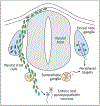Innervation in organogenesis
- PMID: 35461566
- PMCID: PMC10636594
- DOI: 10.1016/bs.ctdb.2022.02.004
Innervation in organogenesis
Abstract
Proper innervation of peripheral organs helps to maintain physiological homeostasis and elicit responses to external stimuli. Disruptions to normal function can result in pathophysiological consequences. The establishment of connections and communication between the central nervous system and the peripheral organs is accomplished through the peripheral nervous system. Neuronal connections with target tissues arise from ganglia partitioned throughout the body. Organ innervation is initiated during development with stimuli being conducted through several types of neurons including sympathetic, parasympathetic, and sensory. While the physiological modulation of mature organs by these nerves is largely understood, their role in mammalian development is only beginning to be uncovered. Interactions with cells in target tissues can affect the development and eventual function of several organs, highlighting their significance. This chapter will cover the origin of peripheral neurons, factors mediating organ innervation, and the composition and function of organ-specific nerves during development. This emerging field aims to identify the functional contribution of innervation to development which will inform future investigations of normal and abnormal mammalian organogenesis, as well as contribute to regenerative and organ replacement efforts where nerve-derived signals may have significant implications for the advancement of such studies.
Keywords: Development; Innervation; Neuron; Organogenesis; Parasympathetic; Sensory; Sympathetic.
Copyright © 2022 Elsevier Inc. All rights reserved.
Figures



Similar articles
-
Regulation of systemic metabolism by the autonomic nervous system consisting of afferent and efferent innervation.Int Immunol. 2022 Jan 22;34(2):67-79. doi: 10.1093/intimm/dxab023. Int Immunol. 2022. PMID: 33982088 Review.
-
Cholinergic neurons and terminal fields revealed by immunohistochemistry for the vesicular acetylcholine transporter. II. The peripheral nervous system.Neuroscience. 1998 May;84(2):361-76. doi: 10.1016/s0306-4522(97)80196-0. Neuroscience. 1998. PMID: 9539210
-
Nerve growth factor expression in parasympathetic neurons: regulation by sympathetic innervation.Eur J Neurosci. 2000 Dec;12(12):4391-7. doi: 10.1046/j.0953-816x.2000.01353.x. Eur J Neurosci. 2000. PMID: 11122349
-
The sympathetic nervous system in development and disease.Nat Rev Neurosci. 2021 Nov;22(11):685-702. doi: 10.1038/s41583-021-00523-y. Epub 2021 Oct 1. Nat Rev Neurosci. 2021. PMID: 34599308 Free PMC article. Review.
-
Neural innervation in adipose tissue, gut, pancreas, and liver.Life Metab. 2023 Jun 6;2(4):load022. doi: 10.1093/lifemeta/load022. eCollection 2023 Aug. Life Metab. 2023. PMID: 39872245 Free PMC article. Review.
Cited by
-
Integrative approaches in cardiac tissue engineering: Bridging cellular complexity to create accurate physiological models.iScience. 2025 Jun 25;28(8):113003. doi: 10.1016/j.isci.2025.113003. eCollection 2025 Aug 15. iScience. 2025. PMID: 40697825 Free PMC article. Review.
-
Neural signaling contributes to heart formation and growth in the invertebrate chordate, Ciona robusta.bioRxiv [Preprint]. 2025 May 2:2025.04.28.651085. doi: 10.1101/2025.04.28.651085. bioRxiv. 2025. PMID: 40654768 Free PMC article. Preprint.
-
A modular platform to generate functional sympathetic neuron-innervated heart assembloids.Res Sq [Preprint]. 2024 Mar 21:rs.3.rs-3894397. doi: 10.21203/rs.3.rs-3894397/v1. Res Sq. 2024. PMID: 38562819 Free PMC article. Preprint.
References
-
- Anderson RB, Newgreen DF, & Young HM (2006). Neural crest and the development of the enteric nervous system. 589. Advances in Experimental Medicine and Biology (pp. 181–196). Springer. - PubMed
-
- Anderson DJ, Carnahan JF, Michelsohn A, & Patterson PH (1991). Antibody markers identify a common progenitor to sympathetic neurons and chromaffin cells in vivo and reveal the timing of commitment to neuronal differentiation in the sympathoadrenal lineage. The Journal of Neuroscience, 11, 3507–3519. 10.1523/JNEUROSCI.11-11-03507.1991. - DOI - PMC - PubMed
MeSH terms
Grants and funding
LinkOut - more resources
Full Text Sources

